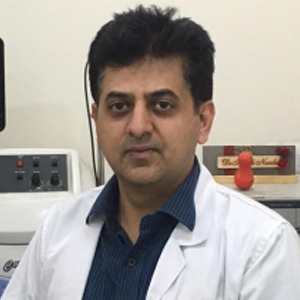
We have state of the art equipment including flexible fibre optic endoscopy for the management of vocal cord disorders. this is supplemented by effective voice therapy. We also have the Lumenis laser for therapy of the vocal cords and various lesions of the throat.
Laser Micro: Laryngoscopic Surgery
Micro laryngeal surgery is a minimally invasive procedure used to correct voice disorders, speaking or breathing difficulties or other problems affecting the larynx.
Larynx which is located in the front of the neck and helps us breathe, swallow and speak as it controls the opening and closing of the windpipe .It is also where the vocal cords are found.
Indications for micro laryngeal Surgery
Sound that comes from the vibration of the vocal cords is the primary source of speaking and singing. Vocal cords are lined bythe mucosa. Any irregularities on or underneath the vocal cord mucosa can make it vibrate abnormally and cause a voice change. Vocal cord polyps, nodules, cysts, and papilloma are some of the benign lesions that can develop on the vocal cords.
Microscopic Laryngeal surgery is done if Laryngeal examinations reveal the source of a persistent cough, hoarseness or various voice problems to be some Nodule, polyp or cyst on the vocal cords
The treatment of vocal cord lesions depends on the nature of the problem and the degree of voice change. Medications, speech therapy and Microlaryngeal surgery are the mainstays of the treatment
What is the Procedure for micro laryngeal surgery?
General anesthesia is required when a patient is undergoing microscopic voice surgery. Laryngoscope is properly placed in the patient’s mouth and navigated into the throat. Special surgical tools are inserted through the laryngoscope and directed into the larynx to reach the vocal folds. Making use of the microinstrumentsand high magnification capabilities, the surgeon approaches the area in which the growth has been identified with precision and care.
Lesion is dissected away and completely removed with the microsurgical cutting tools. This technique allows for incredible accuracy in order to ensure that only the damaged tissue is removed and the surrounding area remains unaffected. Since majority of the laryngeal structure is left intact and completely unharmed, microscopic voice surgery is a minimally invasive technique that offers a rapid healing.
Tonsil and Adenoids Surgery
What are tonsils and adenoids?
Tonsils are lymph-like soft tissue located on both sides of the back of the throat. Along with adenoids (soft tissue behind the nose), tonsils help the body to fight infection by producing antibodies to combat bacteria that enter through the mouth and nose.
What are the symptoms of tonsillitis and adenoiditis?
Tonsils and adenoids can cause health problems when they become infected or obstruct normal breathing or nasal/sinus drainage. Recurring infections in the tonsils can lead to chronic tonsillitis. Symptoms include fever, persistent sore throat, redness of the tonsil area, yellow discharge on the tonsils, and tender lymph nodes on both sides of the neck.
In addition to blocking the throat, enlarged tonsils may interfere with normal breathing, nasal sinus drainage, sleeping, swallowing and speaking. They may also aggravate snoring and can even cause an alarming condition called sleep apnea which involves an occasional stoppage of breathing.
What are the reasons to have a adenoidectomy?
- Sleep apnea, or periods at night when your child stops breathing
- Trouble swallowing
- Tumor in the throat or nasal passage
- Bleeding from the tonsils that cannot be stopped
- Significant blockage of the nasal passage and uncomfortable breathing
The following are adenoidectomy Guidelines from the American Academy of Otolaryngology:
- Seven sore throats in one year
- Five sore throats in each of two years
- Three sore throats in each of three years
The sore throats may be associated with the following:
- Fever above 101º F
- Discharge on the tonsils
- Positive strep throat culture
The following are additional reasons for the removal of the adenoids and tonsils:
- Bad snoring
- Recurrent infections or abscesses in the throat
- Recurrent ear infections
- Hearing loss
- Chronic sinusitis, or infection in the sinuses
- Constant mouth breathing
- Frequent colds
- Cough
Bad breath
What is the treatment of adenoiditis and tonsillitis?
Medical treatment with Antibiotics and symptomatic treatment is given during the acute episodes. Your doctor can guide you if it needs to be operated after proper examination.
Why Coablation?
In traditional Adeno tonsillectomy procedures, adenoids and tonsils are removed by burning or controlling bleeding with cautery. Potential complications are post operative infection bleeding and damage to surrounding structures. Coblation Tonsillectomy and Coablation Adenoidectomy is the world’s most advanced technique for bloodless tonsillectomy and adenoidectomy. Since it is totally bloodless, the procedure is mostly day care. Coblation is an advanced technology that combines gentle radiofrequency energy with natural saline to quickly, and safely remove tonsils. Because traditional procedures use high levels of heat to remove the tonsils, damage to surrounding healthy tissue is common. Coblation does not remove the tonsils by heating or burning, leaving the healthy tissue surrounding the tonsils intact.
Advantages of Coablation Surgery are –
- Less swelling,
- Minimal bleeding
- Minimal discomfort and Reduced Post operative pain
- Shorter hospital stay
- No scarring with minimal incisions
- Quicker Recovery
After the procedure:
Your doctor will provide postoperative instructions, which include antibiotics and oral rinses for up to 1 week some minor pain medication may also be prescribed. It is common for patients who have undergone Coblation Tonsillectomy and Adenoidectomy to feel better than expected following their surgery, with most patients resuming a normal diet and activities within just a few days. Therefore, it is critical that the patient avoid vigorous activity, such as sports, running etc for 14 days after the procedure. This will help to reduce their risk for complications such as postoperative bleeding.
What is coblation tonsillectomy?
Unlike traditional tonsillectomy procedures, which remove tonsils by burning, Coblation is an advanced technology that combines gentle radiofrequency energy with natural saline to quickly, and safely remove tonsils. Because traditional procedures use high levels of heat to remove the tonsils, damage to surrounding healthy tissue is common. Coblation does not remove the tonsils by heating or burning, leaving the healthy tissue surrounding the tonsils intact.How chronic tonsil problems are usually treated?
Depending on symptoms, and the frequency of infection, tonsils are typically treated with antibiotics or removed surgically in a procedure called a tonsillectomy.




